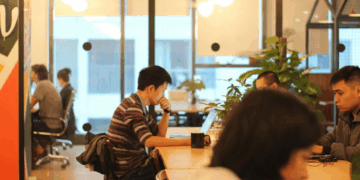- Virtual coworking spaces are not limited by physical boundaries or space.
- They provide many of the benefits of coworking – but to global audiences.
- Operators need to work hard to cultivate a sense of community.
Virtual coworking spaces provide many of the same benefits as physical coworking spaces. The only difference is you don’t need to physically be in the same place as your coworkers.
Instead, you log into a virtual room, Slack channel or other such tech-based forums to collaborate and work with your virtual peers.
In many ways, virtual coworking spaces seem like a natural progression from working from home. You don’t have any of the disruptions of physically working in a shared space, but you do get a sense of community from these online spaces.
There also aren’t any limits on the number of members or the amount of space in the virtual domain. So, a wider range of people can join a virtual space without raising any logistical challenges.
Veronica Kirin, an entrepreneur coach at Audacious Entrepreneur Coaching, also runs the Audacious virtual space. She said: “The biggest benefit a virtual coworking space brings to entrepreneurs is a much larger network, both in distance and in membership size. Physical coworking spaces are limited by square footage – for example, the physical coworking space I helped manage could only accommodate 125 members.”
Kirin added: “A virtual space has no such limitations and members may be from across the world. It also allows one to work from home while still benefiting from the network of a coworking space.”
Tony Lew, CEO and co-founder at virtual coworking space CoSolo, said: “It is also convenient. You don’t have to travel to a physical location, which takes time and effort. You can just get on a Zoom call or Slack channel, and start talking in your pyjamas.”
“Because of these conveniences in logistics and attendance, you can be a lot more creative in what kind of content you provide. You can also get creative with how you run a community with the various technologies that are now available,” Lew added.
But running a virtual coworking space does bring its own challenges. Lew explained: “We need to put a concerted effort into ensuring that people are engaged. It’s a lot easier to join, but also a lot easier to disengage or not actively participate. We put a lot of mechanisms in place to ensure high engagement. For example, we start all of our weekly calls with ice breakers.”
Kirin agrees that attendance is “the biggest challenge I’ve experienced” when running a virtual space. She added: “A virtual coworking space provides greater flexibility, yes, but it also means that people can forget about it as an option. There’s no membership fee associated with mine (it comes with our Facebook group membership instead), which means that if it’s not posted about often, it can be forgotten.”
Jeremy Redleaf is a co-founder of the Caveday virtual coworking space, where individuals log into a 3.5-hour session and work together on projects in an online ‘cave’. He explained: “We’re able to reach people in areas we could never scale to with physical spaces, and we can offer a sense of belonging AND productivity to groups underserved by coworking spaces.”
“The biggest challenge is making it always feel human. How do we keep cultivating a sense of camaraderie and connection despite the technological hurdles? Web cameras are not in the centre of the computer screen, so nobody’s really looking at each other directly in the eye. But, because we work and break together, we’re able to keep a good vibe going and we train our cave guide facilitators to cultivate connections on breaks,” Redleaf added.
Using Virtual Coworking Spaces
So, are virtual coworking spaces actually any good from a user perspective?
Multi-platform entertainment company Multihouse Entertainment has used virtual coworking spaces to help grow its product line in the entertainment and technology fields. These digital workspaces have been used to develop AR experiences, write graphic novels and coordinate massive film productions with the company’s nationwide team of storytellers.
Michael Tessler, CEO of Multihouse Entertainment in Los Angeles, said: “Technology has still not reached the point where virtual coworking has the personal nuances required to replicate the physical experience of sharing an office. This can be frustrating at times but the digital nature of virtual coworking spaces has also emboldened some of our team to be a bit braver in sharing ideas.”
However, Tessler intends to continue to use virtual coworking as the company continues to grow and scale. He said: “Growth that would usually take years has been achieved in months, since we’re able to look beyond geography when building a creative team. Those who would otherwise never have the opportunity to create products in Hollywood are able to do so from the comfort of their home.”
“By using virtual coworking spaces we’ve been able to build our team out considerably faster with branches now in New York, Orlando, soon Atlanta, and by mid-2020 the United Kingdom. Creating one seamless workflow that doesn’t consider geography when hiring talent,” Tessler explained.
Multihouse Entertainment is relocating to a new physical coworking space in Los Angeles. Tessler added: “We’ll push heavily though for hybrid coworking spaces that will allow us to have physical locations gradually as we build our digital teams and workflows. Even with all these advancements in tech, you can’t beat the power or sincerity of a handshake.”




 Dr. Gleb Tsipursky – The Office Whisperer
Dr. Gleb Tsipursky – The Office Whisperer Nirit Cohen – WorkFutures
Nirit Cohen – WorkFutures Angela Howard – Culture Expert
Angela Howard – Culture Expert Drew Jones – Design & Innovation
Drew Jones – Design & Innovation Jonathan Price – CRE & Flex Expert
Jonathan Price – CRE & Flex Expert











